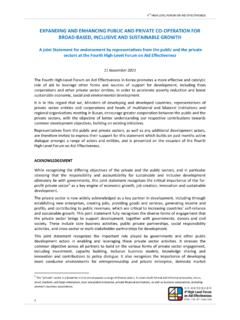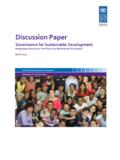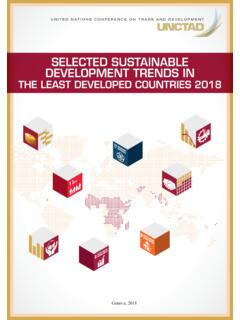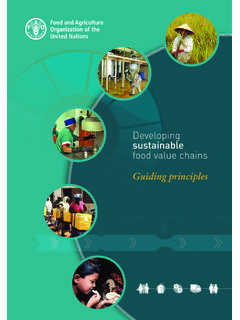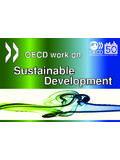Transcription of FOOD AND AGRICULTURE
1 FOOD AND AGRICULTURED riving action across the 2030 Agenda for sustainable Development2 CONTENTSPAGE 4 INTRODUCTIONPAGE 5 FOOD AND AGRICULTURE IN THE 2030 AGENDA PAGE 6 KEY MESSAGES PAGE 7 THE POWER OF PARTNERSHIPSPAGES 8 11 LEAVING NO ONE BEHIND PAGES 12 13 PATH TO ZERO HUNGER BY 2030 PAGES 14 15 NOURISHING PEOPLE, NURTURING THE PLANETPAGES 16 17 FOOD IN A CHANGING CLIMATE PAGES 18 19 BUILDING RESILIENT LIVES PAGES 20 21 FOOD AND AGRICULTURE MATTERPAGES 22 27 COUNTRY STORIESPAGES 28 33 PARTNERSHIPS IN ACTIONPAGES 34 35 TRACKING PROGRESSPAGES 36 37 SUPPORT TO POLICY-MAKINGPAGES 38 39 REFERENCESC over photo: VIET NAM. Good harvest in Pu Luong, Thanh Hoa.
2 FAO/N Tuan AnhFOOD AND AGRICULTURE3 The best way to ensure no one is left behind in 2030 is by addressing root causes. Investments, policies and partnerships aimed at strengthening the resilience and growth potential of poor rural people can achieve great things zero hunger, nourishing food and collective prosperity, all while nurturing the planet. FAO Director-General Jos Graziano da SilvaSIERRA LEONEF armers harvesting cabagges in Sorbeh community near Kabala Town in Koinadugu District in northen Sierra Leone. Sebastian Liste/NOOR for FAO4On 25 September 2015, the 193 Member States of the United Nations adopted the 2030 Agenda for sustainable Development, including 17 sustainable Development Goals (SDGs) with 169 targets and 230 and fully owned by countries, the 2030 Agenda is a global vision for people, for the planet and for long-term prosperity.
3 It charts a plan for the future, shifting the world onto a sustainable and resilient course in leading to a transformation in living 2030 Agenda aims to tackle the complex challenges facing the planet today ending poverty, hunger and malnutrition, and responding to climate change while achieving inclusive growth, building resilient INTRODUCTIONOur planet faces multiple and complex challenges in the twenty-first century. The 2030 Agenda for sustainable Development commits the international community to act together to overcome them and transform our world for present and future and sustainably managing our natural the Millennium Development Goals (MDGs), the SDGs are interlinked, integrating the three dimensions of sustainable development economic growth, social inclusion and environmental protection.
4 Relevant to nations, they call for comprehensive and participatory approaches that bring everybody together to leave no one are now advancing from translating the SDGs to their national plans to implementation, determining how best to commit national efforts to produce transformational change based on their own priorities, needs and POLITICAL FORUMThe 2030 Agenda includes a global reporting structure involving contributions from local, national and regional levels. It culminates in the UN High-Level Political Forum, an annual intergovernmental meeting that provides guidance and recommendations, identifies progress and challenges, and mobilizes action to accelerate implementation of the 17 AND AGRICULTURE5To overcome the great challenges we face today, our future actions must be transformative, embracing the principles of sustainability and tackling root causes to leave no one the fundamental connection between people and the planet, sustainable food and AGRICULTURE are at the heart of the 2030 Agenda.
5 Without proper nourishment, children cannot learn, people cannot lead healthy and productive lives, and societies cannot prosper. Without nurturing our land and adopting climate-resilient AGRICULTURE , future generations will struggle to feed a growing to success will be developing the rural sector, and an approach that focuses on rural , today, is the world s biggest employer and largest economic sector for many countries. Yet rural people who produce 80 percent of our food make up four-fifths of the global poor. A lesson from the MDGs is that we can no longer look at food, livelihoods and the management of natural resources separately.
6 FOOD AND AGRICULTURE IN THE 2030 AGENDAF ocusing on food and AGRICULTURE , investing in rural people and transforming the rural sector can spur progress towards SDG in the comprehensive vision of SDG2, End hunger, achieve food security and improved nutrition and promote sustainable AGRICULTURE , can catalyse achievement right across the 2030 Agenda. The ambition of SDG2 amounts to ensuring people are able to access sufficient nourishing food, sustaining our natural resources and safeguarding biodiversity, transforming food systems and the rural sector while increasing the productivity and income of smallholder farmers, fishers, foresters and pastoralists.
7 Actions to achieve SDG2 will accelerate progress across a great many goals and targets, including poverty (SDG1), health (SDG3), gender equality (SDG5), water (SDG6), economic growth (SDG8), industry, innovation and infrastructure (SDG9), inequality (SDG10), sustainable production and consumption (SDG12), climate change (SDG13), oceans and seas (SDG14), ecosystems, biodiversity and forests (SDG15), and peaceful societies (SDG16).TACKLING SDG2 AND SDG1, HUNGER A N D POV ERT Y, TOGETHERT here is enough food for everyone on the planet today, yet about 800 million people are undernourished. Hunger today is not caused by a lack of supply but because hundreds of millions of people simply cannot afford to buy enough food.
8 At the same time, almost 80 percent of the world s poor live in rural areas, where people depend on AGRICULTURE , fisheries or forestry as their main source of income and food. Vulnerable to climate change and other shocks, they are disproportionately affected by crises, often the first victims of disasters and the degradation of natural MESSAGESINVESTMENT IN FOOD AND AGRICULTURE WILL DRIVE CHANGE ACROSS THE SDGsTO LEAVE NO ONE BEHIND, WE MUST ADDRESS THE NEEDS OF RURAL PEOPLEWE CAN REACH ZERO HUNGER IF WE WORK TOGETHERA ccelerated investment in sustainable AGRICULTURE and food systems, and in rural people is a proven accelerator of sustainable development that helps countries realize multiple SDGs: ending extreme poverty, hunger and malnutrition.
9 Promoting sustainable management of natural resources, including biodiversity, fisheries, forests, land, soils, water, and oceans; and mitigating while also adapting and building resilience to climate people make up nearly 80 percent of the extreme poor, and number billion. To eradicate extreme poverty, reduce the greatest inequalities and foster inclusive growth, we must promote a rural transformation that empowers rural people as critical agents of change. Policies and programmes improving the livelihoods and resilience of smallholder farmers, foresters, fishers, pastoralists and labourers, with particular focus on rural women, indigenous peoples and youth, can make or break achievement of the SDGs in most poverty and hunger by 2030 is feasible if we join forces and act on evidence.
10 Tackling root causes by targeting rural populations, providing access to social protection programmes, committing to pro-poor investment and growth, and promoting sustainable food and AGRICULTURE are top of the policy agenda needed to help countries make the 2030 Agenda s historic commitment become a specialized UN agency, FAO has a long history of working in all three dimensions of sustainable development on projects designed to leave no one behind. The Organization s technical capacity, global reach, monitoring expertise, and experience building partnerships and shaping policy can support countries in implementing the 2030 woman selling fruits and vegetables at the Roberto Huembes Market, in Managua.










